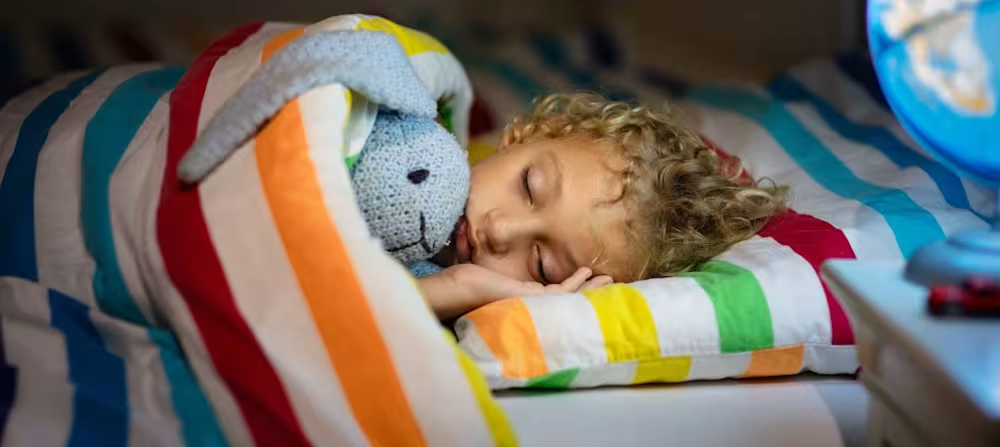Night terrors in toddlers: What you can do
Updated Dec 29, 2025

For most caregivers, it won’t come as a surprise that it’s completely normal for babies and toddlers to sometimes let out a few soft (or loud!) cries or whimpers in their sleep. If you’re experiencing this for the first time with your child — especially if it’s out of character for them — it’s natural to be a bit worried or confused.
Rest assured that a little crying is common between sleep cycles and can sometimes occur due to overtiredness or , or when a baby hasn’t yet mastered sleeping on their own.
Editor's note
For more details about babies and toddlers crying in their sleep — and what you can do about it — check out the top reasons your baby is crying in their sleep.
But the type of night waking that typically begins with a very loud shout or scream is the kind that wakes even the most seasoned caregivers from a deep sleep, gets your heart racing, and is still fresh in your mind the next morning. We’re talking about night terrors in babies and toddlers.
Thankfully, night terrors are much scarier for you than they are for your child. Here's what you can do.
What are night terrors?
Night terrors are episodes of screaming often coupled with flailing that occur while someone is still sleeping. During a night terror, a child will also experience intense fear and may sleepwalk. They're unlikely to remember the event the next morning.
Night terrors occur while babies and toddlers are in deep (non-REM to very light REM) sleep and generally happen within the first 3 - 4 hours after falling to sleep. Night terrors rarely occur during naps and are typically caused by overstimulation of the central nervous system (CNS) during sleep.
Night terror episodes usually last 5 - 10 minutes, but can be as short as a few seconds or as long as 45 minutes. According to one study [], night terrors (also known as sleep terrors) affect nearly 40% of children. Some people use the terms “nightmare” and “night terror” interchangeably, but it’s important to understand that nightmares and night terrors aren’t the same.
How are toddler night terrors different from toddler nightmares?
Although night terrors and nightmares can share some of the same symptoms, night terrors are not simply “more intense” nightmares. In fact, night terrors and nightmares are two entirely different sleep conditions. Nightmares usually happen during REM sleep, while night terrors happen during non-REM sleep. Here are the key differences between the symptoms of nightmares and the symptoms of night terrors in toddlers:
During a night terror, your child may:
Sit up in bed and appear frightened
Scream or shout loudly
Get out of bed and begin sleepwalking
Mumble
Be unresponsive when spoken to
Be inconsolable
Be hard to wake up
Stare wide-eyed but not make eye contact
Act aggressively
Kick or thrash
Sweat excessively
Breathe heavily
Have a racing pulse
Appear flushed
Have dilated pupils
Be confused if awakened
Have no or little memory of the event the next morning
Following a nightmare, your child is likely to:
Wake up fully
Cry out for you
Acknowledge your presence
Be responsive to physical reassurance
Be consoled verbally
Calm down within a few minutes
Remember or describe the dream to you
Night terrors vs nightmares comparison table
| Night terrors | Nightmares |
|---|---|
| Sit up in bed and appear frightened | Wake up fully |
| Get out of bed and begin sleepwalking | Cry out for you |
| Scream or shout loudly | Acknowledge your presence |
| Be unresponsive when spoken to | Be responsive to physical reassurance |
| Act aggressively | Be consoled verbally |
| Be confused if awakened | Calm down within a few minutes |
| Have no or little memory of the event the next morning | Remember or describe the dream to you |
Nightmares can be related to a child’s stage of development, anxiety, stress, or from simply not getting enough sleep. Almost every child will occasionally experience an upsetting or frightening dream.
How to help kids with nightmares
Nightmares are handled differently than night terrors. Here's how you might help your toddler if they're dealing with frequent nightmares:
Institute a regular morning wake-up and bedtime
Use a consistent sleep routine that helps your child unwind and relax before bed
Offer your child a stuffed animal or soft blanket to sleep with
Avoid scary movies, TV shows, and stories
Talk to your child about their fears
Discuss nightmares with your child and help them to understand that nightmares aren’t real and that they are safe
What age do night terrors start?
Night terrors are most common in preschool-aged children around 3 - 4 years old. But toddlers as young as 18 months - 2 years old, and children as old as 7 or 8 years, can experience them as well.
Night terrors age at a glance
1 year old night terrors - not common
18 month old night terrors - very rare
2 year old night terrors - rare
3 year old night terrors - common
4 year old night terrors - very common
When do night terrors go away?
Night terrors are far less common in older children and usually resolve on their own by the time a child reaches puberty.
Causes of night terrors
Various factors can contribute to night terrors, such as:
Sleep deprivation
Chronic overtiredness
Anxiety or stress
Sleep schedule disruptions, such as while traveling
Sleeping in a new environment
Frequent sleep interruptions
Fever or illness
Caffeine
Sleep apnea
Treatment of night terrors in babies and toddlers
Unfortunately, there's no one-size-fits-all night terror remedies. However, there are many ways to help reduce night terrors in toddlers.
To reduce night terrors, it can be helpful to:
Address areas of stress in your child’s life. Consider new living situations, daycare changes, pets that have passed, a new baby, etc.
Avoid screen time at least an hour before bed. This ensures brain-stimulating blue light isn't the last thing they take in before going to sleep.
Implement a consistent and relaxing bedtime routine. This may include a bath, pajamas, turning on , and story time — provided the story isn't scary!
Make sure your child gets enough sleep.
Avoid your child becoming overtired. Having a nap during the day can help ensure toddlers avoid overtiredness at bedtime.
Have an age-appropriate bedtime.
Look for patterns. Are there certain foods or activities that seem to occur frequently before a night terror takes place?
Avoid caffeine.
Ensure your child feels safe in their sleep environment. This may be especially relevant if they've recently transitioned to a toddler bed.
Does my child need to see a doctor or specialist?
Although night terrors are very scary for us as caregivers, they're generally not harmful. Following the prevention tips above can help reduce the occurrence of night terrors. However, talk to your child’s pediatrician or seek out a specialist if you notice any of the following:
Your child jerks, drools, or is stiff while experiencing a night terror
Your child is experiencing night terrors on a regular basis (e.g., two or more times per week)
Your child’s night terrors last longer than 30 minutes
Your child does something dangerous while experiencing a night terror or you have concerns about your child’s safety
You feel family stress may be a factor
Your child expresses daytime fears or anxiety
4 tips for what to do during a night terror episode
Tip | Why it helps | How to put it into practice |
|---|---|---|
Wait it out patiently | Night terrors happen in deep sleep, and waking a child can worsen confusion or prolong the episode | Stay nearby, allow the episode to run its course, and resist the urge to wake or shake them fully alert. |
Stay close and present | Your steady presence provides safety without overstimulating a child who is not truly awake. | Remain in the room, nearby but hands-off unless safety becomes a concern. |
Use a calm, soft voice | Gentle speech can help maintain a soothing environment even if your child doesn’t respond. | Speak quietly and reassuringly, understanding they may not recognize or acknowledge you during the event. |
Protect your child's safety | Kids may thrash or move unpredictably, and preventing injury is the top priority. | Block hazards, guide sleepwalkers away from obstacles, or pad crib edges for older toddlers until the episode passes. |
Find more details below:
1. Patiently wait it out
Although you may be panicked, it’s best not to attempt waking your child up while they’re having a night terror.
2. Stay with your child
Although it’s not recommended that you physically restrain your child or attempt to console them with a hug, you should stay close by until the episode passes.
3. Speak calmly
While your child is having a night terror you can speak softly and quietly, but don’t be surprised if they mumble or don’t respond.
4. Ensure your child’s safety
If your child is sleepwalking, help direct them away from objects they may trip over or run into by putting yourself in between your child and the dangerous object(s). If your child is thrashing in their bed, consider putting pillows or blankets between them and their crib rails or headboard until they settle down (as long as they are older than 1 year).
Takeaway
Night terrors are episodes of screaming often coupled with flailing that occur while a child is still sleeping. They may also experience intense fear and may sleepwalk. However, they are unlikely to remember the event in the morning.
They usually occur when children are in deep sleep, within the first 3 -4 hours after falling asleep. They rarely occur during naps. Night terrors usually last 5 - 10 minutes, but can be as short as a few seconds or as long as 45 minutes.
It's estimated that night terrors affect nearly 40% of children.
Night terrors are different from nightmares. Nightmares happen during REM sleep, which night terrors happen during non-REM sleep. Unlike night terrors, when children have nightmares, they typically wake up fully, cry out for you, are responsive to physical reassurance, and can remember and describe the dream to you.
Night terrors are most common in 3 - 4 year olds, but toddlers may experience them as early as 18 months and as late as 7 - 8 years. They typically resolve on their own by the time a child reaches puberty.
There's not a one-size-fits-all "treatment" for night terrors. However, things like addressing stress in your child's life, avoiding screen time before bed, avoiding overtiredness, maintaining an age-appropriate bedtime, and ensuring your child feels safe in their sleep environment may help reduce them.
When your child has a night terror episode, try patiently waiting it out (instead of trying to wake your little one), staying close by your child (though it's not recommended to restrain your child or attempt to console them through touch until the episode passes), speaking calmly, and ensuring their safety.
If night terrors are persistent or don’t resolve by the time your child reaches puberty, discuss them with your child’s healthcare provider.
Night terrors FAQ
Share article:
Note: The content on this site is for informational purposes only and should not replace medical advice from your doctor, pediatrician, or medical professional. If you have questions or concerns, you should contact a medical professional.
2 Sources
Share article:









